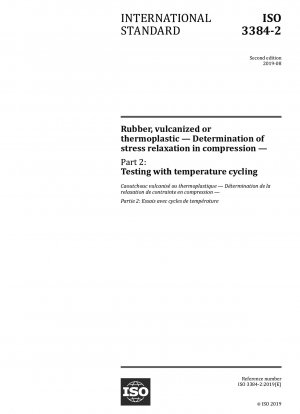ISO 3384-2:2019
Rubber, vulcanized or thermoplastic — Determination of stress relaxation in compression — Part 2: Testing with temperature cycling
- Standard No.
- ISO 3384-2:2019
- Release Date
- 2019
- Published By
- International Organization for Standardization (ISO)
- Latest
- ISO 3384-2:2019
- Scope
- This document specifies two methods for determining the decrease in counterforce exerted by a test piece of vulcanized or thermoplastic rubber which has been compressed to a constant deformation and then undergoes temperature cycling. Method A: The temperature is cycled at intervals between a high temperature for ageing and a low temperature for checking the sealing force at this low temperature. Method B: The temperature is cycled continuously between a high temperature and a low temperature to introduce thermal stress in the test piece. The counterforce is determined by means of a continuous-measurement system. Two forms of test pieces are specified in this document: cylindrical test pieces and rings. Comparison of results is valid only when made on test pieces of similar size and shape. The use of ring test pieces is particularly suitable for the determination of stress relaxation in liquid environments.
ISO 3384-2:2019 Referenced Document
- ISO 18899:2013 Rubber - Guide to the calibration of test equipment
- ISO 188:2011 Rubber, vulcanized or thermoplastic - Accelerated ageing and heat resistance tests
- ISO 23529:2016 Rubber - General procedures for preparing and conditioning test pieces for physical test methods
- ISO 37:2017 Rubber, vulcanized or thermoplastic - Determination of tensile stress-strain properties
ISO 3384-2:2019 history
- 2019 ISO 3384-2:2019 Rubber, vulcanized or thermoplastic — Determination of stress relaxation in compression — Part 2: Testing with temperature cycling
- 2012 ISO 3384-2:2012 Rubber, vulcanized or thermoplastic - Determination of stress relaxation in compression - Part 2: Testing with temperature cycling
